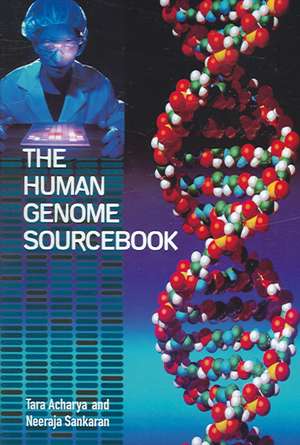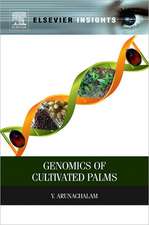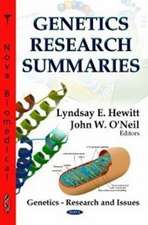The Human Genome Sourcebook
Autor Tara Acharya, Neeraja Sankaranen Limba Engleză Hardback – 29 iun 2005 – vârsta până la 17 ani
Preț: 355.89 lei
Preț vechi: 609.45 lei
-42% Nou
Puncte Express: 534
Preț estimativ în valută:
68.11€ • 73.95$ • 57.21£
68.11€ • 73.95$ • 57.21£
Carte tipărită la comandă
Livrare economică 23 aprilie-07 mai
Preluare comenzi: 021 569.72.76
Specificații
ISBN-13: 9781573565295
ISBN-10: 1573565296
Pagini: 408
Dimensiuni: 178 x 254 x 30 mm
Greutate: 1.02 kg
Editura: Bloomsbury Publishing
Colecția Greenwood
Locul publicării:New York, United States
ISBN-10: 1573565296
Pagini: 408
Dimensiuni: 178 x 254 x 30 mm
Greutate: 1.02 kg
Editura: Bloomsbury Publishing
Colecția Greenwood
Locul publicării:New York, United States
Notă biografică
Tara Acharya is a consultant with the Rockefeller Foundation working on international health issues. She was a research associate at the University of Toronto and has worked as a scientist in the biotechnology industry.Neeraja Sankaran is a freelance writer with training in microbiology and the history of science. She is the author of Microbes and People: An A-to-Z of Microorganisms in Our Lives (Oryx, 2001).
Cuprins
PrefaceOrganizationAcknowledgmentsIntroductionTerms and Concepts in GeneticsThe ChromosomesGenes for Normal FunctionsGenetic Diseases
Recenzii
Acharya and Sankaran provide a remarkably thorough overview of human genetics in this readable presentation of the complex, rapidly changing field of genomics. This sourcebook presents basic biochemistry necessary for readers to understand genes' composition and function. The introduction puts current genetics research into historical context and explores its social implications. Arranged like an encyclopedia, the chapters contain alphabetical entries covering these major topics: terms and concepts in genetics, the chromosomes, genes for normal functions, and genetic diseases. Liberal cross-references link relevant sections, and a thorough index makes it easy to locate topics. The language is straightforward, including some notes on scientists' major discoveries and the development of significant research techniques..In addition to providing a good introduction to the human genome for high school readers, this work could serve as a supporting reference for students in human or medical genetics classes. Recommended. Lower- and upper-division undergraduates, general readers, and practitioners.
Despite the apparent popularity of forensic detective shows and widespread talk of DNA testing, few Americans understand the scientific basis of such ideas. In this volume, a scientist and a freelance science writer team up to explain the basics of genetic theory for the general reader. Following an overview of the progress of genetic research in the past century, the authors define 124 key concepts, from cloning and genetic codes to mutations and gene splicing..Their guide will be useful in both academic and public libraries.
The Human Genome Sourcebook is written for intelligent and curious readers who lack an advanced knowledge of genetics, but who are interested in learning more than just headlines and buzzwords. The book is about the genes that determine how our body is made, how they help us conduct our normal life's activities, and what happens when they are abnormal.
Don't look for yet another book about the Human Genome Project, though of course it's mentioned - Human Genome Sourcebook is much more, discussing what constitutes the human genome, what genes do when they are acting properly and what happens when they're damaged. And even better, it's written with non-specialists in mind: details are inclusive but not so technical the average lay person can't understand, and while it offers extensive in-depth details and chapters in everything from terms and concepts to diseases, its function as an understandable overview isn't lost. A 'must' for any high school or college collection and perfect for public library holdings, as well.
Despite the apparent popularity of forensic detective shows and widespread talk of DNA testing, few Americans understand the scientific basis of such ideas. In this volume, a scientist and a freelance science writer team up to explain the basics of genetic theory for the general reader. Following an overview of the progress of genetic research in the past century, the authors define 124 key concepts, from cloning and genetic codes to mutations and gene splicing..Their guide will be useful in both academic and public libraries.
The Human Genome Sourcebook is written for intelligent and curious readers who lack an advanced knowledge of genetics, but who are interested in learning more than just headlines and buzzwords. The book is about the genes that determine how our body is made, how they help us conduct our normal life's activities, and what happens when they are abnormal.
Don't look for yet another book about the Human Genome Project, though of course it's mentioned - Human Genome Sourcebook is much more, discussing what constitutes the human genome, what genes do when they are acting properly and what happens when they're damaged. And even better, it's written with non-specialists in mind: details are inclusive but not so technical the average lay person can't understand, and while it offers extensive in-depth details and chapters in everything from terms and concepts to diseases, its function as an understandable overview isn't lost. A 'must' for any high school or college collection and perfect for public library holdings, as well.










